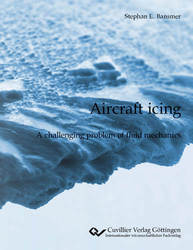| Departments | |
|---|---|
| Book Series (96) |
1378
|
| Nachhaltigkeit |
3
|
| Gesundheitswesen |
1
|
| Humanities |
2363
|
| Natural Sciences |
5406
|
| Engineering |
1791
|
| Engineering | 292 |
| Mechanical and process engineering | 861 |
| Electrical engineering | 686 |
| Mining and metallurgy | 30 |
| Architecture and civil engineering | 75 |
| Common |
98
|
|
Leitlinien Unfallchirurgie
5. Auflage bestellen |
|
Advanced Search
Aircraft icing (English shop)
A challenging problem of fluid mechanics.
Stephan Bansmer (Author)Preview
Extract, PDF (320 KB)
Table of Contents, PDF (33 KB)
In 2018, approximately 4.3 billion passengers were carried by scheduled flights in the member states of the International Civil Aviation Organization. To satisfy the needs of day and night flight operations even in situations of inclement weather, aircraft icing is an inherent component of the certification of large transport aircraft. Ice detection and protection systems ensure flight safety and must be designed carefully. The reliable prediction of ice accretion is a mandatory intermediate step that involves many challenging problems of fluid mechanics that will be treated in this volume. After introducing the topic of aircraft icing with a brief historical overview of technological and scientific progress over the last century, current challenges from the perspective of fluid mechanics are outlined. In particular, the governing boundary conditions of the phenomenon are highlighted, accompanied by remarks on non-dimensional groups and scaling laws. Selected physical properties of water and ice are elucidated. Classic ice accretion is usually triggered by the impact of supercooled droplets on a surface. After analysing the solidification process of supercooled water, drop impact is studied on both dry and wetted substrates. Macroscopic phenomena of ice accretion are considered using a combined approach of experiments and computations. To carry out experimental investigations, the Braunschweig Icing Wind Tunnel was built. Together with the results of the icing code TAUICE, the gathered data are used to develop a deeper understanding of the process of glaze ice accretion, which involves a broad range of physical phenomena, including wetting, roughness formation, transitional flow and heat transfer.
| ISBN-13 (Hard Copy) | 9783736972247 |
| ISBN-13 (eBook) | 9783736962248 |
| Final Book Format | other |
| Language | English |
| Page Number | 140 |
| Edition | 1. |
| Publication Place | Göttingen |
| Publication Date | 2020-06-23 |
| General Categorization | Habilitation |
| Departments |
Technical mechanics
|
| Keywords | aircraft icing, inclement weather, certification of large transport aircraft, flight safety, ice accretion, fluid mechanics, scaling laws, supercooled droplets, solidification, drop impact, splashing, Braunschweig Icing Wind Tunnel, icing code TAUICE, glaze ice accretion, wetting, roughness formation, transitional flow and heat transfer, Vereisung von Flugzeugen, Zertifizierung von Verkehrsflugzeugen, Flugsicherheit, Eisansatz, Strömungsmechanik, Skalierungsgesetze, unterkühlte Tropfen, Erstarrung, Gefrieren, Tropfenaufprall, Splashing, Braunschweiger Mehrphasen- und Vereisungswindkanal, Vereisungscode TAUICE, Klareis, Benetzung, Rauheitsbildung, Transition laminar-turbulent, Wärmeübertragung, Nachtflug, Eisakkumulation, Erstarrungsvorgang, Rauhigkeitsbildung, Wärmeübertragung, Regelvolumen, Feuchtigkeit, drag coefficient, Lift coefficient, skin-friction coefficient, drag coefficient, acceleration vector, Force, Kraft, Brennweite, Focal length, Free energy, solidification, gravitational acceleration, Gravitationsbeschleunigung, Latent heat of fusion, relative humidity, Latente Schmelzwärme, Latent heat of sublimation, Molekulare Masse, Flüssigwassergehalt, Liquid water content, Wärmeleitfähigkeit, thermal conductivity coefficient, Boltzmann-Konstante, Boltzmann constant, specific enthalpy, Dreiecksmatrix, triangular matrix, static pressure, Turbulenzgrad, Turbulence level, Kamerakoordinate, camera coordinate, catch efficiency |








